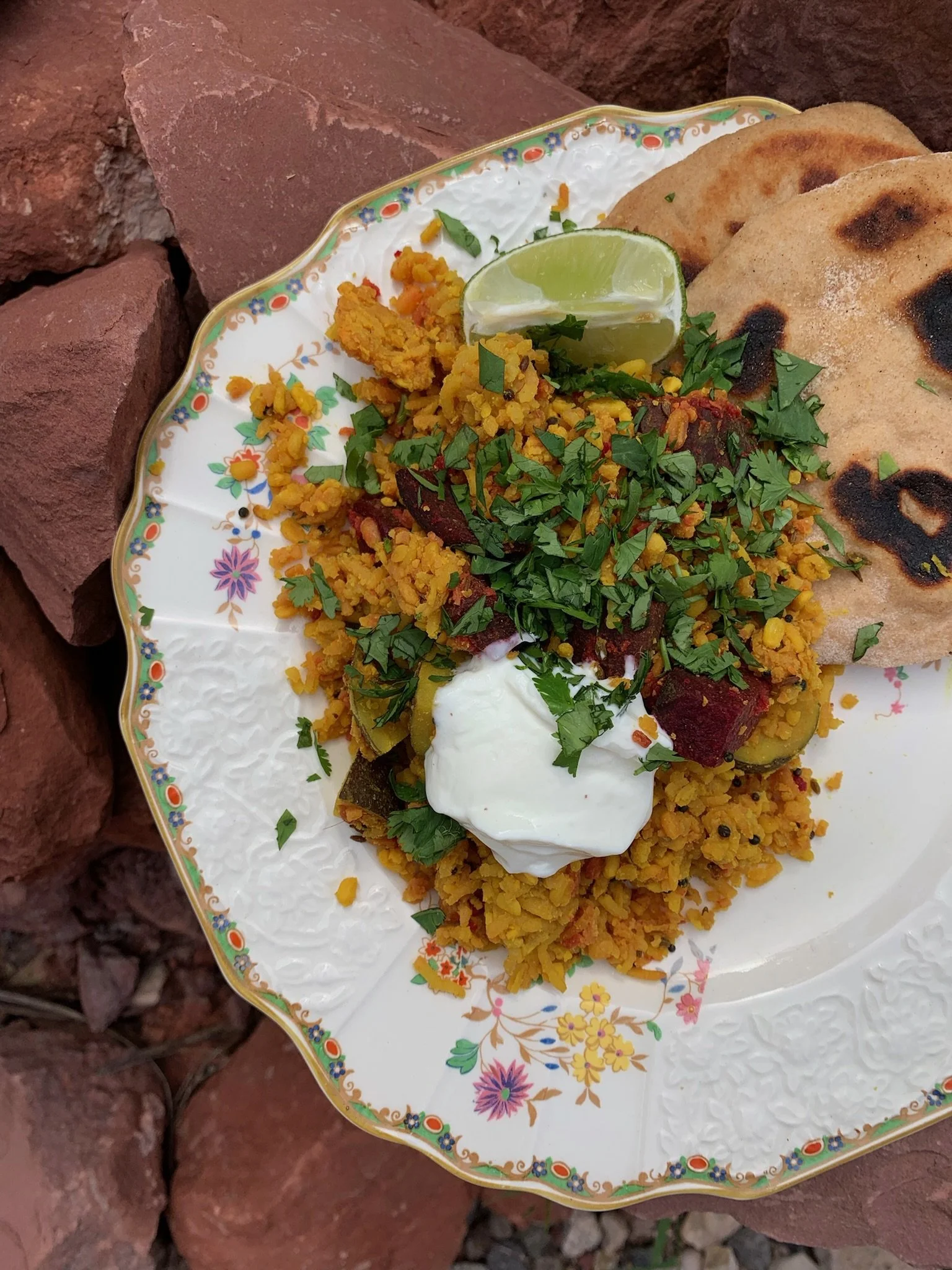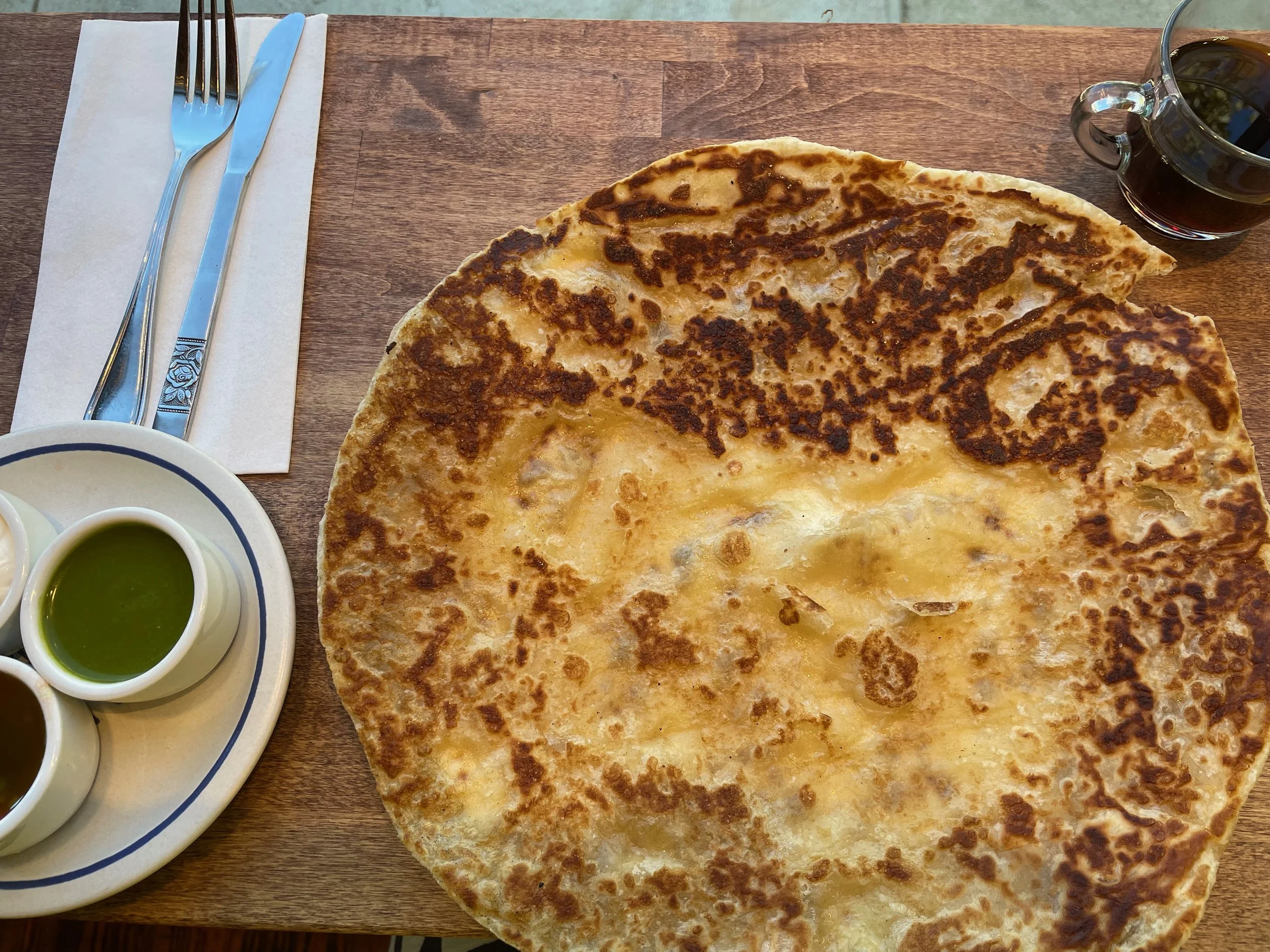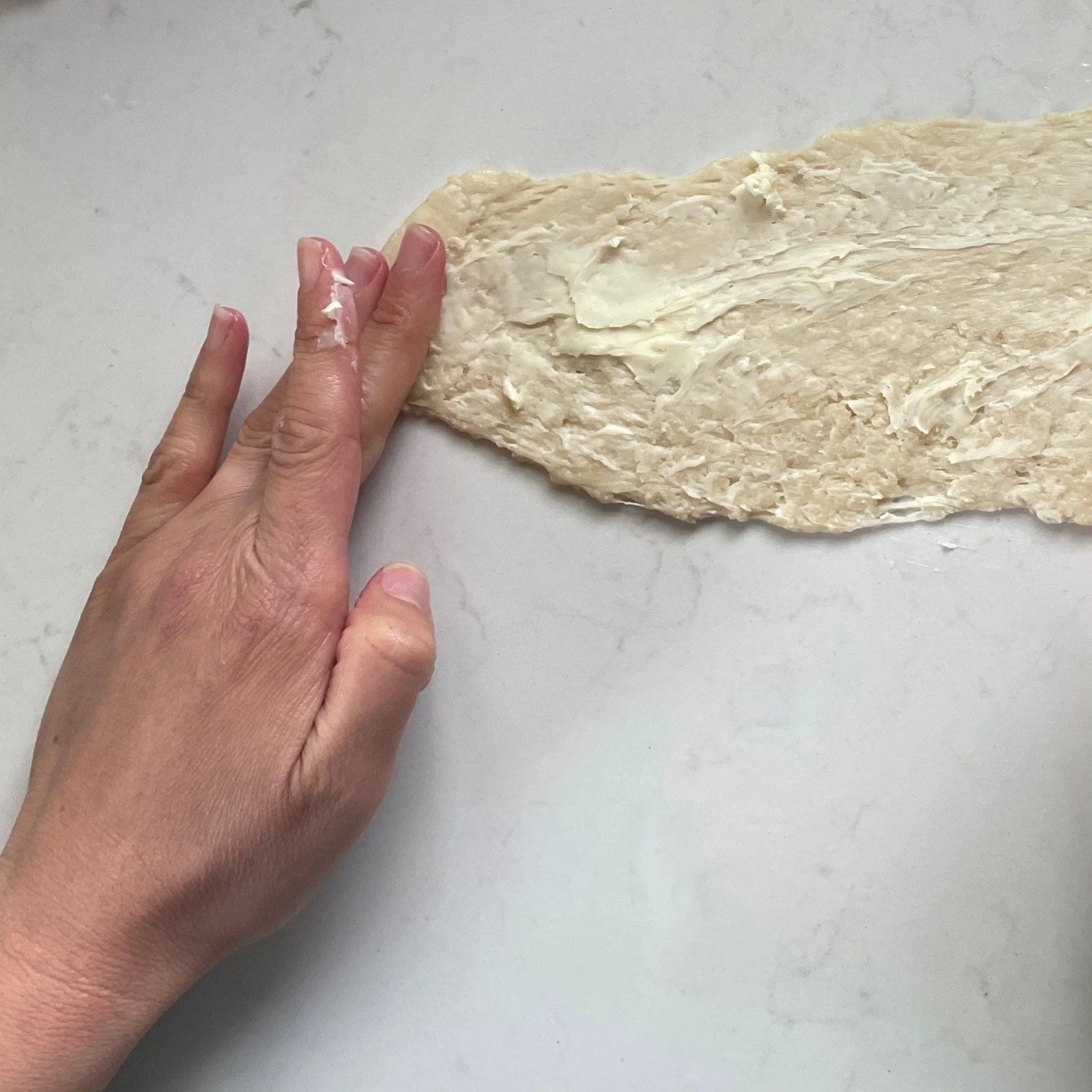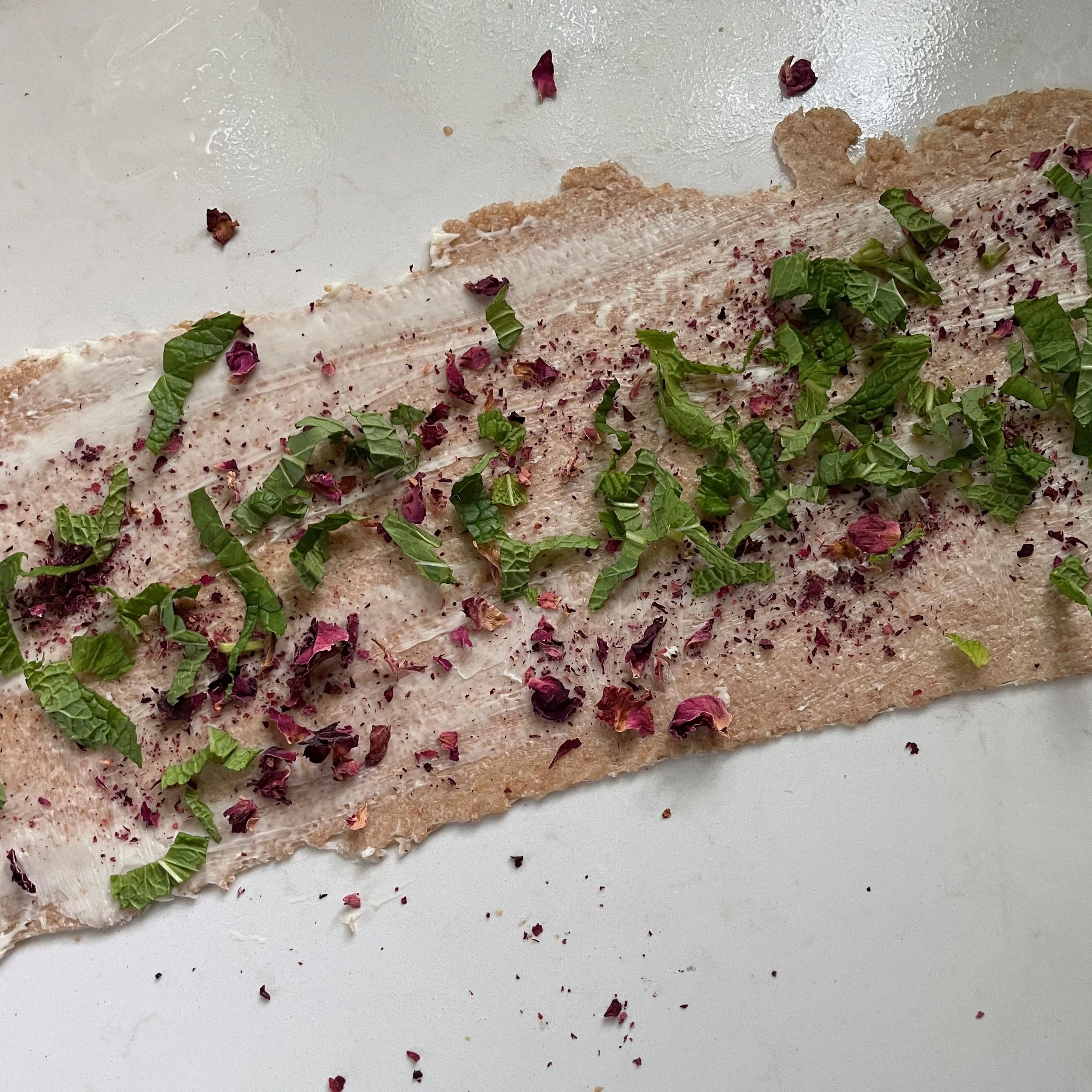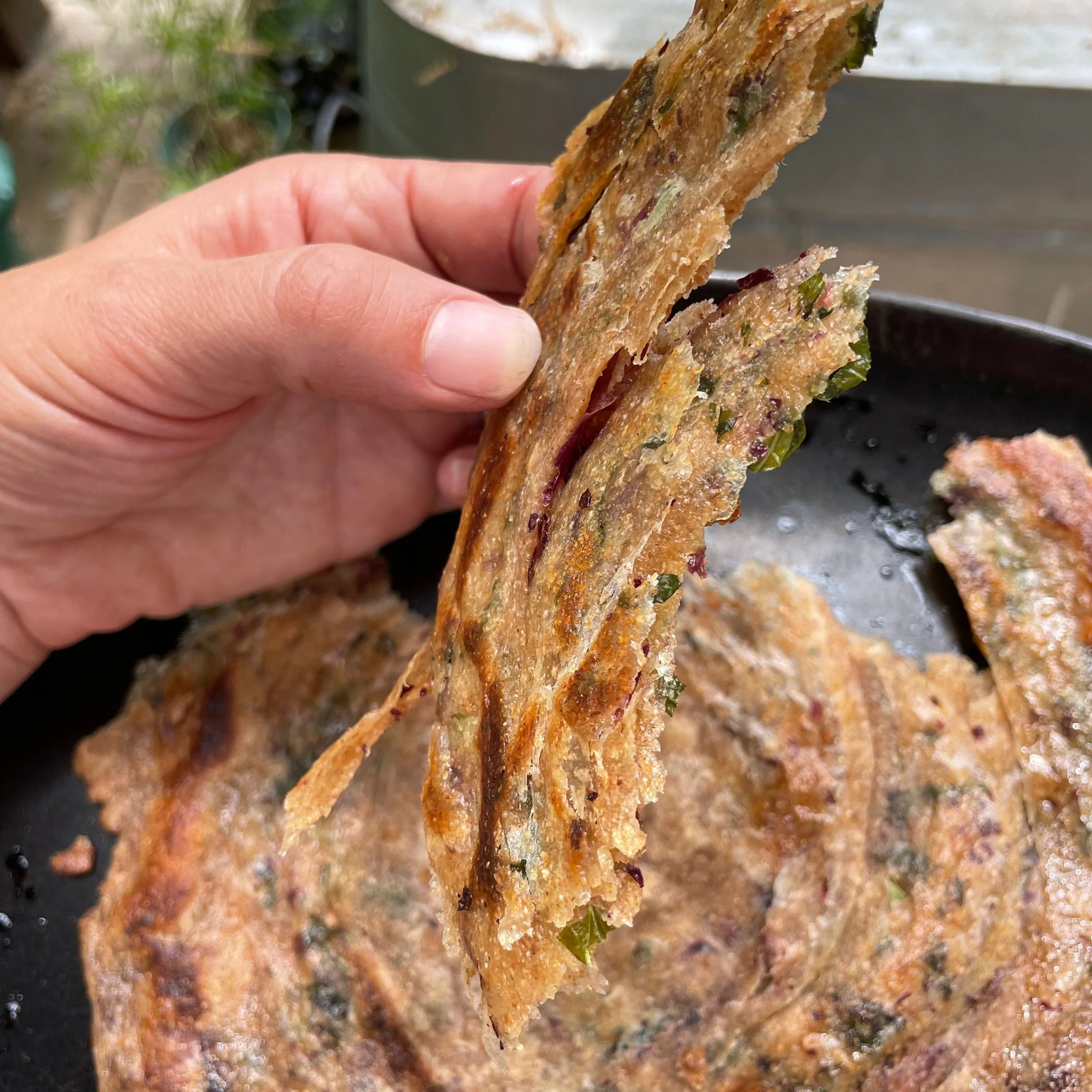Ambition (Spiral flatbread with rose petals and mint)
I started making flatbreads a year ago.
I was preparing for the women’s retreat I cooked for last September in Sedona. I knew I wanted the opening dinner of the retreat to be participatory. Flatbread felt like a fun thing for the women to roll out and cook together. I made batch after batch, even at the retreat, when I started a batch over after adding too much salt. I arrived on a dough made with Arizona-milled farro flour, tinged with turmeric and ajwain seeds. It was good, complementing the beet and potato kitchari we made together.
Photo credit @auddds
When I returned from Sedona, I continued my flatbread experiments, trying different flours and techniques inspired by Naomi Duguid and Jeffrey Alford’s flatbread atlas published 30 years ago. And then, I found malawach, a Jewish Yemenite breakfast bread similar to paratha. Hannah Goldfield mentioned malawach in her “Tables for Two” column in The New Yorker, which my husband reads aloud to me in bed, and my curiosity took me to Edith’s in Williamsburg to try it. The bread was as big as the plate, served with the traditional accompaniments, grated tomato and green chile s'ḥug, as well as homemade jam and labne. I ate the whole thing. The laminated dough was like a flat fried croissant, and when I held a piece up to the window, I could see the light through it. “What’s the recipe?” I asked the waitress. “Chef’s secret,” she replied. Fair enough. My flatbread ambition had new direction.
Malawach at Edith’s in Williamsburg
Ambition is a loaded word. I always resisted identifying myself with it. In our culture, the idea of an “ambitious woman” often has a negative cast to it – she’s not satisfied, she wants more, striving for promotion or advancement, or just to do something differently. How dare she. It startled me a little, then, when a staff member at the local food pantry where I volunteer sent me an email that began like this: “My ambitious dedicated Sarah, Feeding Westchester is hiring,” linking to a job our countywide food bank had just posted for a Chief Operating Officer.
Ambition in this context, the context in which she knew me, wasn’t about promotion or advancement. I work for free, I have no title, receive no peer feedback or performance reviews. But I have a vision for how our food pantry can operate more sustainably, with more community involvement and partnership, making more fresh food available to the 100 families who depend on us. I’ve been steadily working toward that vision, building a team of volunteers, implementing systems of communication and organization to get us closer every day. If that’s ambition, I have no shame about it. I applied for the job. And kept making flatbread, because I had a vision of what I wanted it to be and I hadn’t reached it yet.
I turned to a basic recipe for malawach from a borrowed copy of The Jewish Cookbook by Leah Koenig, its blue cover embossed with gold and silver spirals. The results were promising, more pliable than previous flatbread techniques I’d used. Laminating dough sounds intimidating, but when I actually spread the butter across the dough with my fingers, I loved it, like a child painting. It was not difficult, but it did require time and dedication. I rolled the buttered dough into snakes and snails, flattened it, fried a few. I ate them, and I knew I could go further.
I opened my pantry, found the last of the Hayden farro flour I brought back from Arizona, and the end of a bag of locally milled all-purpose flour, wheat fibers visible in the grain. I mixed the flours with sugar, salt, and water in the ratios suggested by Koenig, kneaded it, let it rest, rolled it out. Fingerpainting again with the softened butter, this time sprinkling fresh mint leaves and dried rose petals on top. I was inspired by a flower workshop I had taken the week before – we arranged flowers and used the leftovers to dye bandanas.
Now my canvas was not cloth but dough, the colors of the leaves and petals peeking through on my second rolling. Fried in foaming butter, the mint and musky petals breathed, the dough bubbling and browning until I decided it was ready.
Whether I get the job or not — and at the time of this publication, it looks like they are moving forward with other candidates — the process of applying for it was like turning on a pilot light for my dreams. Writing my cover letter and rewriting my resume, I remembered all the really hard things I’ve accomplished. I feel like I can do, literally, anything. I imagined what I could do with my skills in a new context, blending my tech experience and humanist heart in service of food and community. On a very local level, I’m already doing that, both for our food pantry and at our farmers market, where I’m leading a project recording community stories and running programs connecting the market’s abundance with the pantry’s needs. I know more is possible.
I ate my ambition with my hands, dipping crispy edges in thick yogurt but mostly savoring the flatbread plain. The mix of grains, leaves, and petals tasted alive. The vision held between the speckled flaky layers was beautiful, and the spiraling journey to get there is my own.
Recipe as feeling: Ambition (Spiral flatbread with rose petals and mint)
-
Dig deep in your soul's pantry.
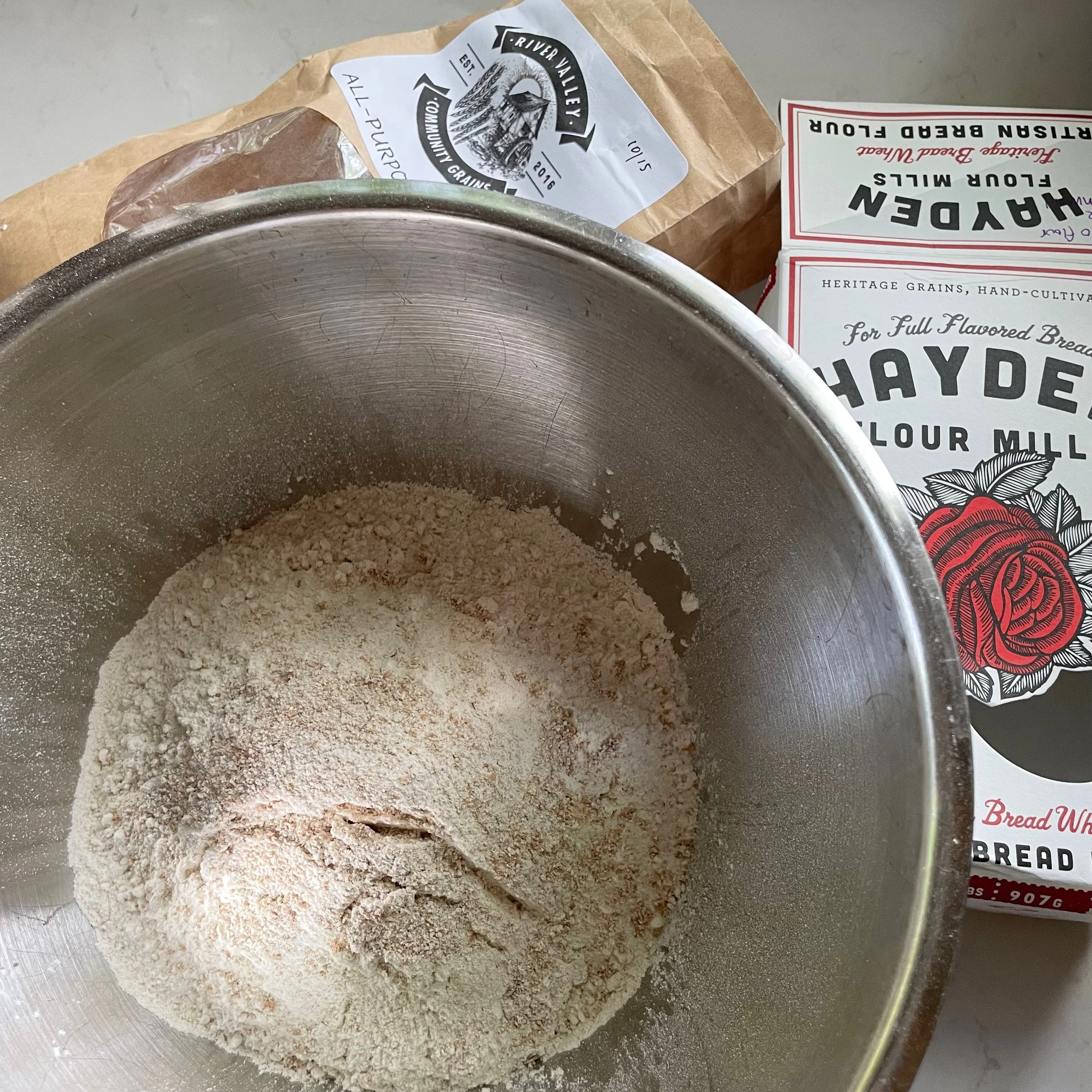
-
Find inspiration in other forms.
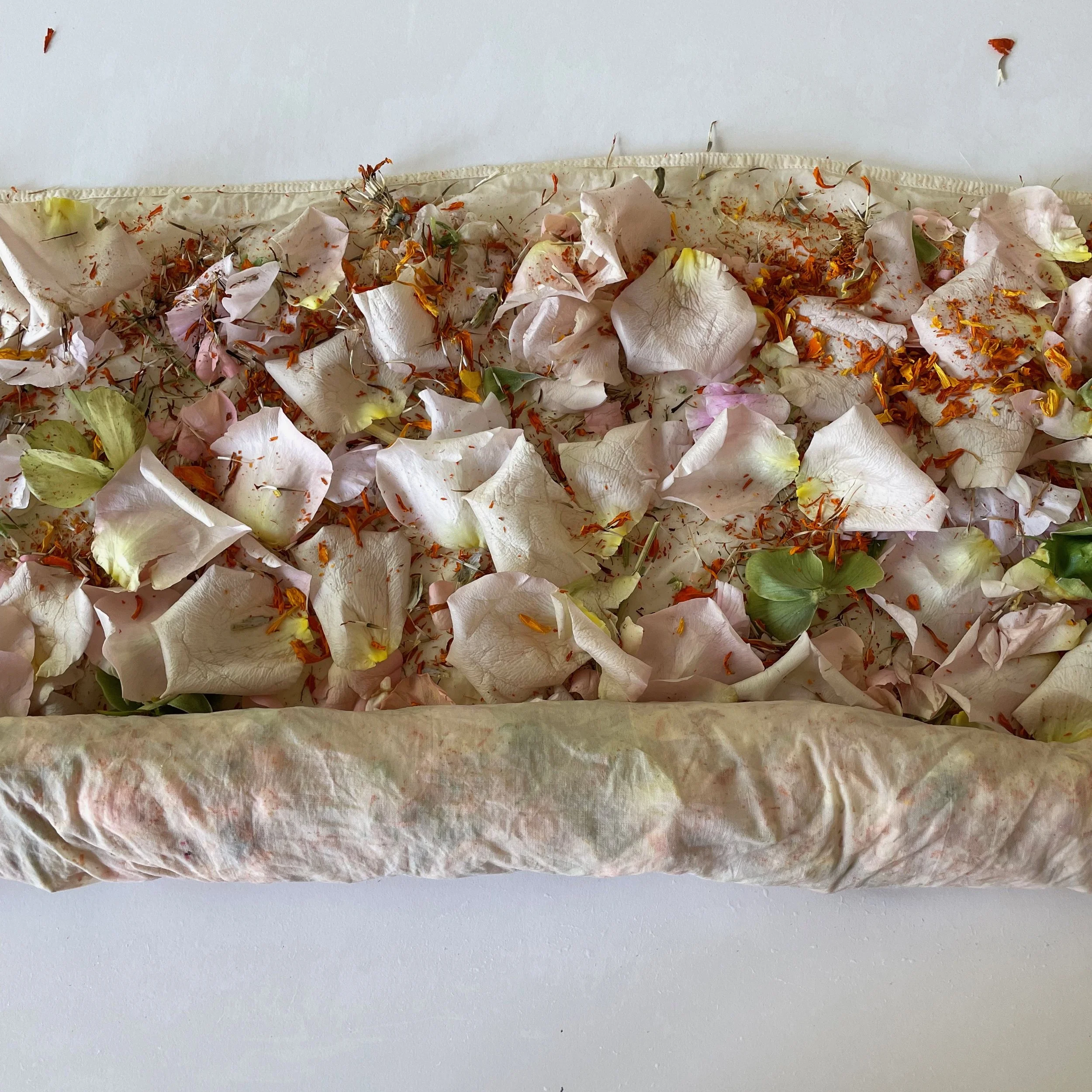
-
Let your light shine through.
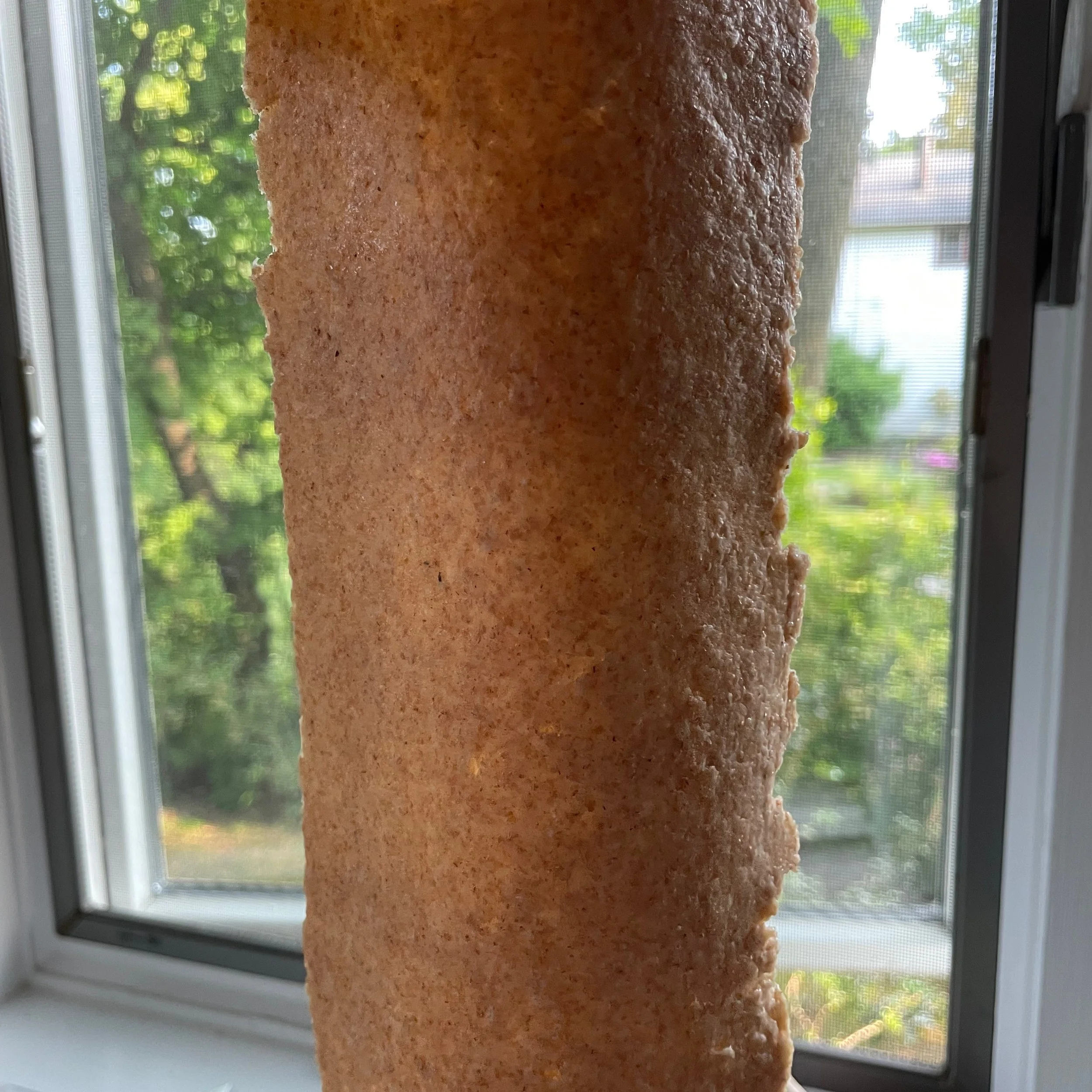
-
Create your own path.
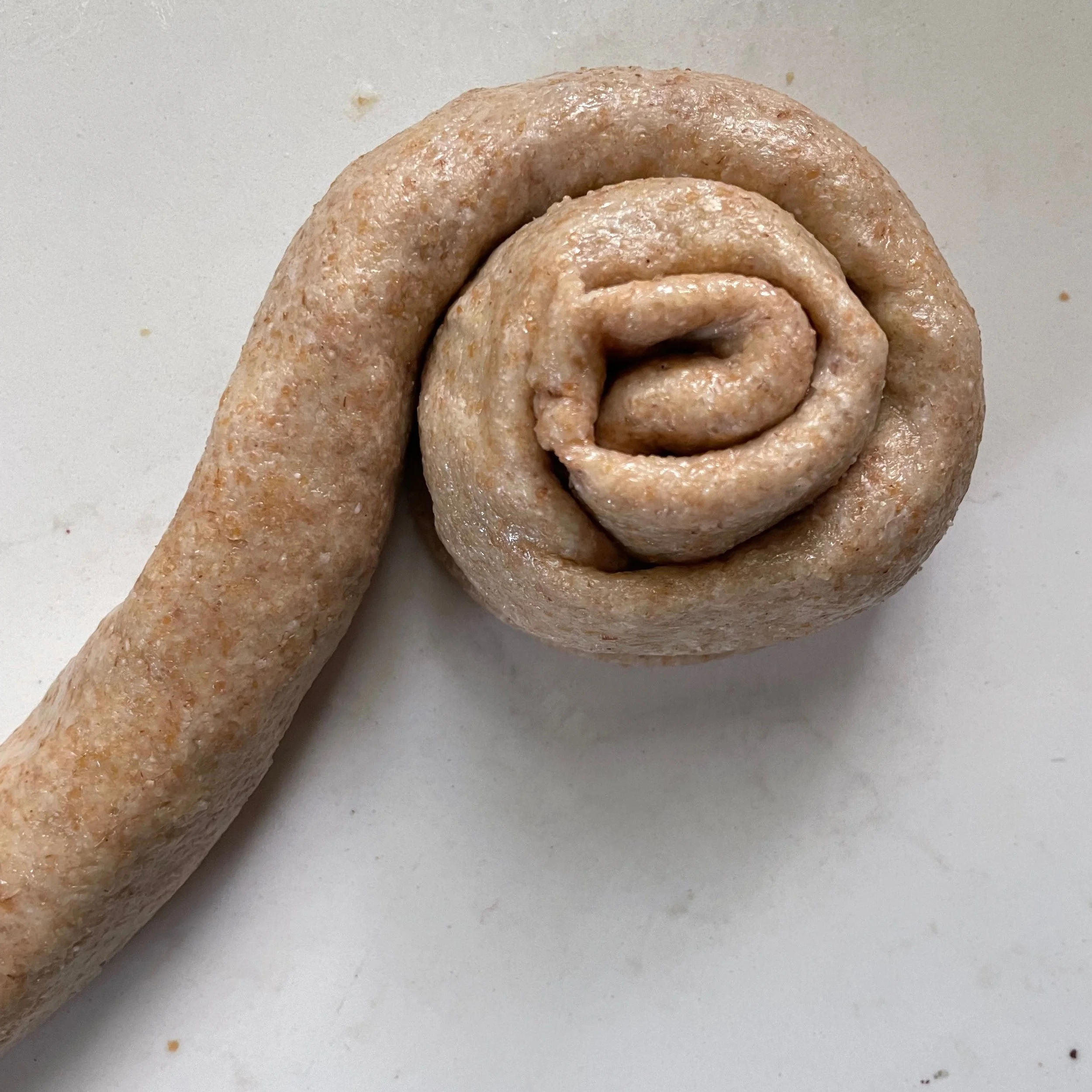
Actual recipe
Spiral flatbread with rose petals and mint (malawach)
This is Leah Koenig’s recipe from The Jewish Cookbook, with my adaptation of different flowers and adding fresh herbs and dried flowers. Factor in time to chill the dough overnight before rolling it out a second time and cooking it; you can also freeze the final rolled-out dough between parchment paper and cook it another day.
Makes 8 very rich flatbreads
INGREDIENTS:
300g whole wheat or fresh-milled all-purpose flour
225g farro flour
65g (1/3 cup) sugar
2 1/2 tsp kosher salt
1 cup (240ml) water
1 stick unsalted butter, softened
Fresh mint leaves, roughly chopped
Dried rose petals
EQUIPMENT:
Stand mixer with paddle and hook attachments
Large bowl
Rolling pin
Bench scraper (optional)
Large frying pan
Whisk together the flours, sugar, and salt. With the paddle attachment and your mixer on low speed, add the water and mix until the dough comes together, then knead with the dough hook or your hands until the dough is smooth, about 5 minutes. Cover the bowl and rest for 30 minutes.
Divide the dough into 8 pieces, keeping the pieces you’re not working with sealed in a plastic bag (if it dries out, it becomes harder to roll out thin). One at a time, roll each piece out into a long rectangle as thin as you can, and smear butter all over it. Sprinkle the mint and dried rose petals on top. Roll the buttered dough into a snake (long tube) and then a snail (spiral) shape, and then seal in a plastic bag while you repeat with the other pieces. Chill the buttered snails overnight, well sealed in plastic.
Again working with one piece at a time, flatten the snail with your hand and then roll it out as thin as you possibly can. You may need to scrape it from the counter and repeat a few times until the dough is thin enough. You can pile the rolled out dough between pieces of parchment paper and freeze in a sealed plastic bag until you’re ready to cook them, or fry them right away in hot butter. Eat immediately with whatever accompaniments you like — the traditional ones are grated tomato and green chile s'ḥug, or honey. Thick plain yogurt is good, or chickpeas and harissa and greens, or an egg…or just plain, torn in pieces with your hands.
Published May 24, 2023
If you’d like new posts delivered to your inbox, you can subscribe via Substack. There’s no charge, just your participation.

